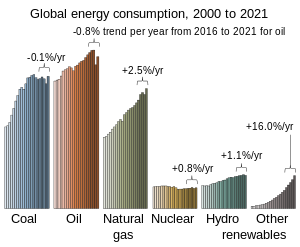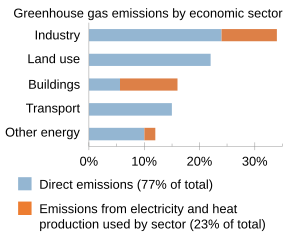User:Clayoquot/Clean energy
Clean energy
[edit]The emissions reductions necessary to keep global warming below 2 °C will require a system-wide transformation of the way energy is produced, distributed, stored, and consumed.[1] Many climate change mitigation scenarios envision three main aspects of a low-carbon energy system:
- The use of low-emission energy sources to produce electricity
- Increased use of electricity instead of directly burning fossil fuels
- Accelerated adoption of energy efficiency measures[2]
Renewable energy sources such as wind, solar, and hydropower generally produce low GHG emissions, however some renewable energy projects raise significant sustainability concerns. Nuclear energy, etc...
1 sentence on integrating variable renewables...
Some energy-intensive technologies and processes are difficult to electrify, including aviation, shipping, and steelmaking. For some applications, the most prominent alternative to electrification is to develop a system based on sustainably-produced hydrogen fuel.[3]
Full decarbonization of the global energy system is expected to take several decades and can mostly be achieved by deploying existing technology.[4] The International Energy Agency states that further innovation in the energy sector, such as in battery technologies and carbon-neutral fuels, is needed to reach net-zero emissions by 2050.[5] The transition to a zero-carbon energy system would bring strong co-benefits for human health: The WHO estimates that efforts to limit global warming to 1.5 °C could save millions of lives each year from air pollution alone.[6][7] With responsible planning and management, pathways exist to provide universal access to electricity and clean cooking by 2030 in ways that are consistent with climate goals.[8][9]
Clean energy
[edit]

Long-term decarbonisation scenarios point to rapid and significant investment in renewable energy,[11] which includes solar and wind power, bioenergy, geothermal energy, and hydropower.[12] Fossil fuels accounted for 80% of the world's energy in 2018, while the remaining share was split between nuclear power and renewables;[13] that mix is projected to change significantly over the next 30 years.[14] Solar and wind have seen substantial growth and progress over the last few years; photovoltaic solar and onshore wind are the cheapest forms of adding new power generation capacity in most countries.[15] Renewables represented 75% of all new electricity generation installed in 2019, with solar and wind constituting nearly all of that amount.[16] Meanwhile, nuclear power costs are increasing amidst stagnant power share, so that nuclear power generation is now several times more expensive per megawatt-hour than wind and solar.[17]
To achieve carbon neutrality by 2050, renewable energy would become the dominant form of electricity generation, rising to 85% or more by 2050 in some scenarios. The use of electricity for other needs, such as heating, would rise to the point where electricity becomes the largest form of overall energy supply.[18] Investment in coal would be eliminated and coal use nearly phased out by 2050.[19]
In transport, scenarios envision sharp increases in the market share of electric vehicles, and low carbon fuel substitution for other transportation modes like shipping.[20] Building heating would be increasingly decarbonized with the use of technologies like heat pumps.[21]
There are obstacles to the continued rapid development of renewables. For solar and wind power, a key challenge is their intermittency and seasonal variability. Traditionally, hydro dams with reservoirs and conventional power plants have been used when variable energy production is low. Intermittency can further be countered by demand flexibility, and by expanding battery storage and long-distance transmission to smooth variability of renewable output across wider geographic areas.[11] Some environmental and land use concerns have been associated with large solar and wind projects,[22] while bioenergy is often not carbon neutral and may have negative consequences for food security.[23] Hydropower growth has been slowing and is set to decline further due to concerns about social and environmental impacts.[24]
Low-carbon energy improves human health by minimizing climate change and has the near-term benefit of reducing air pollution deaths,[25] which were estimated at 7 million annually in 2016.[26] Meeting the Paris Agreement goals that limit warming to a 2 °C increase could save about a million of those lives per year by 2050, whereas limiting global warming to 1.5 °C could save millions and simultaneously increase energy security and reduce poverty.[27]
- ^ United Nations Environment Programme 2019, p. 46.
- ^ IPCC 2014, 7.11.3.
- ^ Cite error: The named reference
:18was invoked but never defined (see the help page). - ^ Jaccard 2020, p. 203, Chapter 11 - "Renewables Have Won".
- ^ IEA 2021, p. 15.
- ^ World Health Organization 2018, Executive Summary"If the mitigation commitments in the Paris Agreement are met, millions of lives could be saved through reduced air pollution, by the middle of the century."
- ^ Vandyck, T.; Keramidas, K.; Kitous, A.; Spadaro, J.V.; et al. (2018). "Air quality co-benefits for human health and agriculture counterbalance costs to meet Paris Agreement pledges". Nature Communications. 9 (1): 4939. Bibcode:2018NatCo...9.4939V. doi:10.1038/s41467-018-06885-9. PMC 6250710. PMID 30467311.
- ^ United Nations Environment Programme 2019, pp. 46–55.
- ^ IPCC SR15 2018, p. 97: "Limiting warming to 1.5 °C can be achieved synergistically with poverty alleviation and improved energy security and can provide large public health benefits through improved air quality, preventing millions of premature deaths. However, specific mitigation measures, such as bioenergy, may result in trade-offs that require consideration."
- ^ Friedlingstein et al. 2019.
- ^ a b United Nations Environment Programme 2019, p. 46; Vox, 20 September 2019; Sepulveda, Nestor A.; Jenkins, Jesse D.; De Sisternes, Fernando J.; Lester, Richard K. (2018). "The Role of Firm Low-Carbon Electricity Resources in Deep Decarbonization of Power Generation". Joule. 2 (11): 2403–2420. doi:10.1016/j.joule.2018.08.006.
- ^ Teske et al. 2019, p. 163, Table 7.1.
- ^ REN21 2020, p. 32, Fig.1.
- ^ Teske, ed. 2019, p. xxiii.
- ^ IEA 2020a, p. 12; Ritchie 2019
- ^ The Guardian, 6 April 2020.
- ^ Dunai, Marton; De Clercq, Geert (23 September 2019). "Nuclear energy too slow, too expensive to save climate: report". Reuters.
The cost of generating solar power ranges from $36 to $44 per megawatt hour (MWh), the WNISR said, while onshore wind power comes in at $29–56 per MWh. Nuclear energy costs between $112 and $189. Over the past decade, (costs) for utility-scale solar have dropped by 88% and for wind by 69%. For nuclear, they have increased by 23%.
- ^ United Nations Environment Programme 2019, p. XXIII, Table ES.3; Teske, ed. 2019, p. xxvii, Fig.5.
- ^ IPCC SR15 Ch2 2018, p. 131, Figure 2.15; Teske 2019, pp. 409–410.
- ^ IPCC SR15 Ch2 2018, pp. 142–144; United Nations Environment Programme 2019, Table ES.3 & p. 49.
- ^ IPCC AR5 WG3 Ch9 2014, p. 697; NREL 2017, pp. vi, 12
- ^ Berrill et al. 2016.
- ^ IPCC SR15 Ch4 2018, pp. 324–325.
- ^ "Hydropower". iea.org. International Energy Agency. Retrieved 12 October 2020.
Hydropower generation is estimated to have increased by over 2% in 2019 owing to continued recovery from drought in Latin America as well as strong capacity expansion and good water availability in China (...) capacity expansion has been losing speed. This downward trend is expected to continue, due mainly to less large-project development in China and Brazil, where concerns over social and environmental impacts have restricted projects.
- ^ Watts et al. 2019, p. 1854; WHO 2018, p. 27
- ^ Watts et al. 2019, p. 1837; WHO 2016
- ^ WHO 2018, p. 27; Vandyck et al. 2018; IPCC SR15 2018, p. 97: "Limiting warming to 1.5°C can be achieved synergistically with poverty alleviation and improved energy security and can provide large public health benefits through improved air quality, preventing millions of premature deaths. However, specific mitigation measures, such as bioenergy, may result in trade-offs that require consideration."
